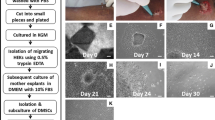Abstract
To investigate the characteristics of multilineage-differentiating stress-enduring (Muse) cells labeled with chloromethyl dialkylcarbocyanine (CM-Dil) in culture and in skin wounds of rats. Normal human dermal fibroblasts (NHDFs) were obtained from foreskins and were confirmed by immunocytochemistry with vimentin. Muse cells were derived from NHDFs using long-term trypsinization (LTT), were confirmed using immunocytochemistry with antibodies against stage specific embryonic antigen-3 (SSEA-3) and CD105 and were expanded in suspension cultures. The Muse cells were labeled with CM-Dil and were further evaluated with respect to their biological properties using CCK-8 assays and scratch tests. One hundred µl CM-Dil-labeled Muse cells at a concentration of 5 × 103/µl were injected subcutaneously at the edges of skin wounds in adult male SD rats. At weeks 1, 3 and 5 after the injection, the distribution of CM-Dil-labeled Muse cells in skin tissues was observed using immunofluorescence microscopy. Muse cells were double-positive for CD105 and SSEA-3. ALP staining of the M-clusters were positive and they displayed orange-red fluorescence after labelling with CM-Dil, which had no adverse effects on their viability, migration or differentiation capacity. One week after the subcutaneous injection of CM-Dil-labeled Muse cells, many cells with orange-red fluorescence were observed at the edges of the skin injuries; those fluorescent spots gradually decreased over time, and only a few Muse cells with fluorescence could be detected by week 5. CM-Dil can be used to label Muse cells without affecting their proliferation, migration or differentiation, and can be used for short-term tracking of Muse cells for the treatment of skin wounds in a rat model.






Similar content being viewed by others
References
Cao JK, Yang ZG, Xiao R et al (2020) Regenerative potential of pluripotent nontumorgenetic stem cells: multilineage differentiating stress enduring cells (Muse cells). Regen Ther 15:92–96
Darkazalli A, Levenson CW (2012) Tracking stem cell migration and survival in brain injury: current approaches and future prospects. Histol Histopathol 27:1255–1261
Ji F, Duan HG, Zheng CQ et al (2015) Comparison of chloromethyl-dialkylcarbocyanine and green fluorescent protein for labeling human umbilical mesenchymal stem cells. Biotechnol Lett 37:437–447
Kinoshita K, Kuno S, Ishimine H et al (2015) Therapeutic potential of adipose-derived SSEA-3-positive Muse cells for treating diabetic skin ulcers. Stem Cells Transl Med 4:146–155
Kitada M, Dezawa M (2009) Induction system of neural and muscle lineage cells from bone marrow stromal cells; a new strategy for tissue reconstruction in degenerative diseases. Histol Histopathol 24:631–642
Kuroda Y, Kitada M, Wakao S et al (2010) Unique multipotent cells in adult human mesenchymal cell populations. Proc Natl Acad Sci 107:8639–8643
Kuroda Y, Kitada M, Wakao S et al (2011) Bone marrow mesenchymal cells: how do they contribute to tissue repair and are they really stem cells? Arch Immunol Ther Exp 59:369–78
Lin CS, Xin ZC, Dai J et al (2013) Commonly used mesenchymal stem cell markers and tracking labels: limitations and challenges. Histol Histopathol 28:1109–1116
Liu Q, Zhang RZ, Li D et al (2016) Muse cells, a new type of pluripotent stem cell derived from human fibroblasts. Cell Reprogram 18:67–76
Mao XQ, Cheng Y, Zhang RZ et al (2022) RNA-seq and ATAC-seq analyses of multilineage differentiating stress-enduring (Muse) cells: comparison with dermal fibroblasts. Cell Biol Int 46(9):1480–1494
Hu MS, Longaker MT (2017) A muse for skin regeneration. J Invest Dermatol 137:2471–2
Progatzky F, Dallman MJ, Lo CC (2013) From seeing to believing: labelling strategies for in vivo cell-tracking experiments. Interface Focus 3:20130001
Sohni A, Verfaillie CM (2013) Mesenchymal stem cells migration homing and tracking. Stem Cells Int 2013:130763
Staffend NA, Meisel RL (2011) DiOlistic labeling of neurons in tissue slices:a qualitative and quantitative analysis of methodological variations. Front Neuroanat 5:14
Tatsumi K, Kushida Y, Wakao S et al (2018) Protocols for isolation and evaluation of Muse cells. Adv Exp Med Biol 1103:69–101
Wakao S, Akashi H, Kushida Y et al (2014) Muse cells, newly found non-tumorigenic pluripotent stem cells, reside in human mesenchymal tissues. Pathol Int 64:1–9
Wei H, Ooi TH, Tan G et al (2010) Cell delivery and tracking in post-myocardial infarction cardiac stem cell therapy: an introduction for clinical researchers. Heart Fail Rev 15:1–14
Zheng JH, Zhang JK, Kong DS et al (2020) Quantification of the CM Dil-labeled human umbilical cord mesenchymal stem cells migrated to the dual injured uterus in SD rat. Stem Cell Res Ther 11:280
Acknowledgements
The authors are very grateful to Professor Elizabeth Hearing for help with the English‐language editing. This study was supported by funds of Pudong New Area Science and Technology Development (PKJ2019-Y55) and the Project fund of Shanghai Pudong New Area Health Committee (PW2021A-21).
Author information
Authors and Affiliations
Contributions
YC, KG and TH performed the experiments and contributed to data analysis, YC and JN wrote the manuscript. ZR designed the experiments, provided experimental materials and supervised the experimental work. All authors read and approved the final manuscript.
Corresponding author
Additional information
Publisher's Note
Springer Nature remains neutral with regard to jurisdictional claims in published maps and institutional affiliations.
Rights and permissions
Springer Nature or its licensor (e.g. a society or other partner) holds exclusive rights to this article under a publishing agreement with the author(s) or other rightsholder(s); author self-archiving of the accepted manuscript version of this article is solely governed by the terms of such publishing agreement and applicable law.
About this article
Cite this article
Cao, Yy., Ning, J., Zhang, Rz. et al. Characterization of CM-Dil-labeled Muse cells in culture and in skin wounds in rats. Cell Tissue Bank 25, 285–294 (2024). https://doi.org/10.1007/s10561-022-10067-9
Received:
Accepted:
Published:
Issue Date:
DOI: https://doi.org/10.1007/s10561-022-10067-9




